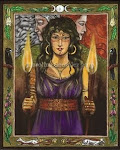Thursday, December 3, 2015
Top Posts about Powerful Women in the Ancient World
As followers of the goddess we inadvertently support women and woman in all her aspects. So it's good to know some history, or herstory rather, of some of our ancient powerful women forebears who took the world by storm. The following list was comprised of the five most popular posts from this blog which I've written about powerful ancient women. Click on each title to read the full post.
Zenobia, Warrior Queen of Palmyra: Zenobia was born Around 240 CE in the Palmyrene Empire, which was known as Roman Syria. She was thought to be of Arab descent and claimed to be related to Queen Cleopatra and Queen Dido of Carthage. She became wife to Septimius, the King of Palmyra, in 258 CE. Septimius had a son from his first wife when he married Zenobia, and then he and her had a son of their own, Vaballathus. This name is said to have come from an Aramaic term meaning "The Gift of the Goddess"....
Hypatia of Alexandria: Hypatia lived in Roman Egypt around 370 CE to about 415 CE, and was a noted mathematician and philosopher. She was daughter to the mathematician Theon Alexandricus, who was also a librarian at the library of Alexandria. Hypatia was educated in Athens and Italy, and was a Neoplatonist. Which means that she took her teachings from the mystical philosophy of Plato, she was also schooled by Plotinus who was a Neoplatonist philosopher as well. In around 400 CE, she became head of the Platonist school......
Hatshepsut, Great Pharaoh of Ancient Egypt: Hatshepsut was the fifth Pharaoh of the eighteenth Egyptian dynasty. Born in 1508 BCE, she was daughter to Thutmose I, and wife to Thutmose II. It is said by Egyptologist's that her reign was longer than any other woman in Egypt, lasting for twenty two years, and that she was quite successful. She was said to have been favored over her two brothers, and when they both died it became possible for her to ascend the throne upon the death of her father. Although Thutmose I already had his stepson, Thutmose II was in line to marry Hatshepsut and become Pharaoh. Hatshepsut became Queen alongside.......
Jezebel, Princess of Phoenicia, Queen of Israel: Jezebel was a Phoenician princess around 900 BCE. Daughter to Ethbaal, king of Tyre in Phoenicia, and wife to Ahab, king of northern Israel. It is said by many archaeologists and scholars that Jezebel was really the one in charge, not her husband and king. She still honored her ancient religion and did not covert to Judaism. She convinced her husband to worship her Phoenician God Baal, who was seen as a God of fertility, rain and the seasons. They had temples erected in his honor which was seen as sinful by the other Israelite's......
Queen Cleopatra VII of Egypt: I recently came to the realization that in all the years I've had my blog and written about powerful women, I've never written about my own personal idol, Queen Cleopatra VII. Cleopatra was born in Alexandria in 69 B.C.E. Daughter to Ptolemy XII, her family came from a long line of royalty stretching all the way back to Alexander the Great. The identity of her mother is somewhat unknown. Some speculate that it was Cleopatra V but others say it was an Egyptian concubine which would make Cleopatra part Egyptian. Her family was Greek in origin and came to Egypt from Macedonia many years earlier......
Subscribe to:
Post Comments (Atom)




One supposes little girls need such role models and your choices are exquisite. As we move away from a Feminist future and extinction to true spirituality and Mother Goddess, I would hope young women look to a coming new paradigm where matriarchs rule and a Priestess of Sexuality takes Beasts to school transforming culture up the evolutionary ladder.
ReplyDeleteMay I add queen Artemisia of Karia? A real amazone, admiral and one of the first advisors at the Persian court. She was the queen of a little state at the coast of Asia Minor, ruling for her son who was still a child. During the Persian war 480 BC she was an ally of the Persians. King Xerxes listened to her advice as much as to his nearest satrapes - in a culture where women did not appear in public at all and had to remain in their rooms until their husbands called for them.
ReplyDeleteArtemisia joined the Persian invasion and participated with her own ships at the sea-battle at Salamis, where she accidentally destroyed on of the Persian ships. Nevertheless, she could explain the accident in a way that the king did not punish her. On the contrary, he praised her for her tactics and shall have said" Now men have become women, while women became men" ( if we can believe Herdotus...). After loosing the battle, Xerxes spent the winter in Macedonia and sent his sons home to Susa under the command of Artemisia.... a Persian High King gave the most precious he had, his sons and probably the life of the next king, in the hands of a woman.....He, who hold his First wife and hundred of concubines separated from the mundane world.
Herodotus, who normally mentioned women solely as ".....daugther of....", "wife to...." wrote several pages about Artemisia of Karia.
Yes Ingrid thank you! I have been wanting to do a post about Queen Artemisia.
Delete